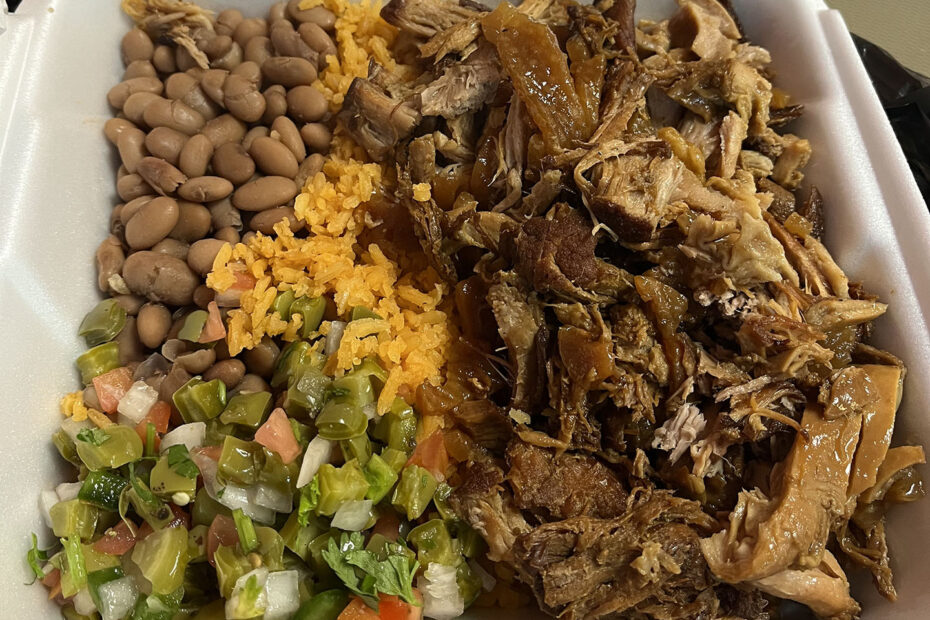If you have ever been to a Mexican restaurant, you have probably seen carnitas on the menu. From Chipotle to Red Iguana, carnitas have entered the American lexicon along with carne asada as a quintessential taco filling. There are countless recipes (Bobby Flay has one he would love you to try!), where pork shoulder is slow-cooked with orange juice, oregano, cumin, and chili powder until fork-tender, shredded, and then broiled in the oven until crisp. While delicious, the story of carnitas goes much deeper than that.
The origin of carnitas is mysterious; it is said that when Hernán Cortés colonized the area that is now known as Mexico in 1521, he ordered pigs initially brought over from Spain to be slaughtered and cooked in their own lard for a feast, with corn tortillas provided by the Tlaxcalan people. Historians have questioned this tale, but what is more certain is that the carnitas began to flourish a century later in the state of Michoacan, particularly in the town of Quiroga. The signature of the town is the Cazo de Cobre, giant copper pots, which allow the entire pig to simmer in its own fat for hours. Similar to the French confit, the process allows for moisture to be slowly drawn out of the meat and replaced with fat.
Notice I said they cook the entire pig. We most often see carnitas that only involve the maciza, or pork shoulder, in restaurants; however, the traditional cook allows for the preparation of cueritos (skin), costillas (ribs), buche (stomach), patita (foot), and a variety of organs. The cooking process requires a skilled chef; the lard must be kept at the exact right temperature with the different parts of the pig added at the exact right moments. The skin must be added early to break down its collagen, but not too early so as not to become rubbery. The heat must be turned up at the end of the cook to crisp but not burn the maciza and costilla. Carnitas are not an item you traditionally cook weekly – butchering and slow cooking are done only on special occasions. Thus, if you want to find a place that makes carnitas Michoacan, it should be one of the only things they make.
There are three places I know of in Utah that make Carnitas Michoacan. The first is Carnitas Mi Nino, located in an unassuming strip mall in West Valley. While there are a couple of other items on the menu, the lines of people (sometimes out the door) that stream in and out are only carrying pounds and pounds of carnitas. You know the carnitas are serious when you can specify what cuts you want, a little more costilla, a little less maciza. I generally ask for carnitas surtida – an even mixture of it all. The mixture of the gelatinous cuerito mixed with the meaty maciza is the perfect bite for me. The carnitas plate comes with rice, beans, and an ensalada de nopales, a cactus salad made with onion, tomato, cilantro, and lime juice that serves as a tart contrast to the rich carnitas. Be sure to get there before the most popular cut, the costilla, runs out in the morning. Taylorsville Carnitas and West Valley Carnitas are two other spots I know of to find carnitas Michoacan in the valley. Be sure to go on the weekend to West Valley Carnitas, where you can sample other organs in your dishes, such as liver, heart, and kidney.
If you have never tried carnitas the Michoacan way, you owe it to yourself and your taste buds to change that.
Purchase a subscription
Subscribe to our paid newsletter for $5 and help keep our stories free of automated advertising
Subscribe NowOther useful links
- Free newsletter – signup and receive our weekly newsletter for free
- Food talk group – chew the fat with other like-minded Utah foodies over on Facebook.
- Best of SLC 2024 – what you can’t miss in the Beehive right now.
This article may contain content provided by one of our paid partners. These are some of the best businesses in Utah. For a list of all our current and past relationships see our partnership history page.

Absolutely great piece I will have to try these places!